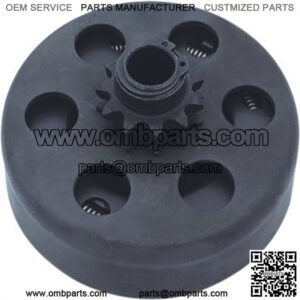How does a go-kart clutch work?
Once I got back home, I decided to have a closer look at what clutches go-karts use. As expected, go-karts use centrifugal clutches. These work through centrifugal forces, making me hope that I had paid closer attention to my physics classes in high school.
From what I could gather, a couple of flyweights transmit the centrifugal force created from the engine to the clutch. The clutch’s hub then rotates at the same speed as the engine, which leads the clutch’s flyweights to touch the clutch drum.
Through the friction of the flyweights with friction material on the drum, the torque transmits from the flyweights to the drum. This, in turn, makes the wheels rotate and allows you to drive the kart.
This is the more scientific answer to how a go-kart clutch works. I never expected that go-karts need an engineering degree to fully understand everything that’s going on inside of them.
But, to put it simply, a go-kart clutch is a transmission that’s activated automatically when the engine reaches a certain RPM. When the engine is idling (around 1500-2000 RPM), the clutch shouldn’t engage; otherwise, it gets destroyed (which subsequently leads to it smoking).
How long does a Go-Kart clutch last?
From my experience so far, I’ve understood that go-karts are incredibly high-maintenance. Now I know why everyone calls their go-kart their “baby”. I came across a video by the Power Republic, and I was baffled to see how much work is going into maintaining a go-kart.
Apart from the maintenance tips, that video helped me understand how important it is to properly install the parts of your go-kart. And since we’re talking about go-kart clutches, it’s crucial to install a clutch the right way. Elliot’s Shop does a perfect job at explaining how to install a go-kart clutch.
But you’re wondering what this has to do with how long a go-kart clutch lasts. Well, if you install the clutch on the engine crankshaft correctly, your go-kart clutch can last for many years. You’ll also need to not drive in harsh conditions (rugged terrain, abnormal weight load, large tires); otherwise, the clutch will last much less time.
Of course, if your go-kart clutch isn’t correctly installed and you take it for a spin at the nearest beach, don’t expect it to last for more than half an hour.
When to replace a clutch in my go-kart?
If you’re like me, you’ve never inspected your go-kart clutch. But, unfortunately, you and I can’t truly know how badly damaged the clutch is if we never check it out. Thankfully, there are a bunch of crucial signs that the clutch requires replacement.
Your Go-Kart Can’t Idle
If your kart is unable to idle, it’s because the clutch is severely damaged. More specifically, the clutch shoe is probably obliterated or cracked in several parts. So why’s this happening?
When your clutch is damaged, it doesn’t produce enough centrifugal force, which leads to the engine cutting off. This happens at lower revs, which is when the engine is idling (below 2000 RPM). As a result, your kart doesn’t idle on its own.
Your Go-Kart Has Lost Power
While the loss of power might not be significant when it comes to top speed, your kart’s acceleration takes a huge hit when the clutch is damaged. This is most evident in slower corners and straights.
That happens because the clutch can’t transmit the engine’s power to the wheels at an optimal rate. So, if you notice that other racers fly by you on the straights or right after corners, it’s time to change the clutch.
The Engine’s Sound Is Different
While this might not always be a fault of the clutch, a rattling noise is likely due to a clutch malfunction. If the clutch shoe is destroyed, then you’ll notice that noise at lower revs.
Then again, if you can put your go-kart on a stand, you’ll get a better idea of what might be wrong. If you rev the engine and you hear a clanking noise, it’s probably the pieces of the clutch shoe that are broken grinding against the clutch drum.
How do you adjust a go-kart clutch?
While it’s easy to understand when you should replace a go-kart clutch, it’s much harder to actually replace it or adjust it. But, I’ll try to describe this as adequately as I can, so that you can do it on your own.
You’ll firstly need to remove the clutch. Yeah, I know that it’s easier said than done. Thankfully, there are tons of videos online on how to remove a go-kart clutch, and you can find some really detailed videos on that process on YouTube.
Once you’ve got the clutch in your hands, you should make sure that everything is well-greased. Clutches tend to stick or lock, so ensuring that everything is moving freely is crucial, and it can save a lot of time.
However, if your go-kart clutch is still slipping or not slipping enough, you’ll need to adjust it accordingly. To do that, you’ll have to get your hands dirty with wrenches and Allen keys.
So, to get more slip, you’ll have to use the wrench to turn the clutch so that the oil plugs face 12 and 6 o’clock, respectively. You’ll then have to remove the plug next to the 12 o’clock one and use the Allen key to adjust the engine’s screws.
If you’ve over-adjusted the clutch, you’ll need to stop the kart and readjust the screws to the other side. You’ll have to keep doing that until you’ve found the perfect amount of slippage.
This might seem complicated (and believe me, it is), but it can make you go much faster.
How do I know if my go-kart torque converter is bad?
Before I started go-karting, I didn’t even know that some karts use torque converters and others use clutches. From what I understood, on one hand, go-kart torque converters are better if the go-kart is driven in medium to low revs and on off-road tracks. On the other hand, a go-kart clutch is an optimal transmission for go-kart races.
So, I went around asking how differently go-kart torque converters get damaged compared to clutches. From what I gathered, the drive belt that surrounds the converter is usually the part that gets damaged most easily. Here are some telltale signs that your go-kart torque converter is damaged.
Your Go-Kart Keeps Moving While Idling
Unlike go-kart clutches, if the torque converter is faulty, the kart will move on its own despite the engine idling. This is often due to the belt being installed wrongly or being too short. You’ll need to have a look at the torque converter in order to identify what’s wrong.
Your Go-Kart’s Acceleration Is Poor
If you have a problem accelerating on the straights or after corners, there’s a problem with the torque converter. Just like the clutch, you’ll need to lubricate the torque converter sufficiently and make sure that everything is connected optimally.
The Belt Is Damaged In Several Ways
If the torque converter belt gets damaged in any way, you’ll need to replace it. Even if it’s partially worn out, it can lead to many problems when you’re racing. You can check this out by simply looking at the go-kart torque converter and searching for any issues with the belt.
“Keyword”
“how a go kart centrifugal clutch works”
“how does a go kart clutch work”
“how to make a homemade go kart clutch”
“how to tighten go kart clutch”
“how to install go kart clutch”
“how to get a go kart clutch off”
“how a go kart clutch works”
“how does a centrifugal clutch work on a go kart”

